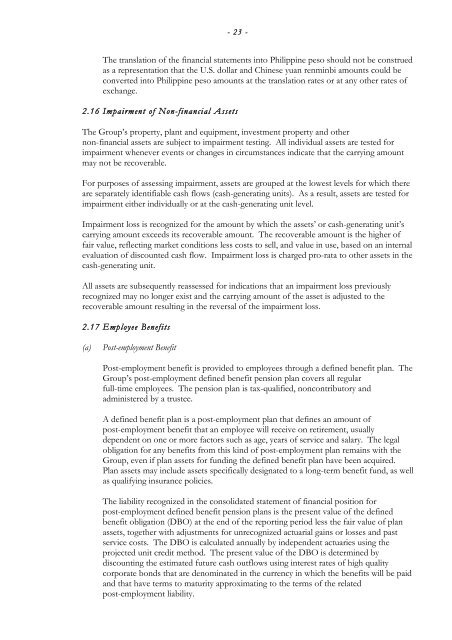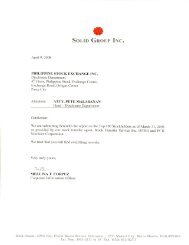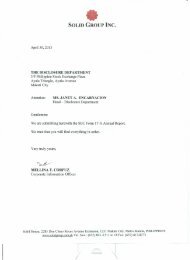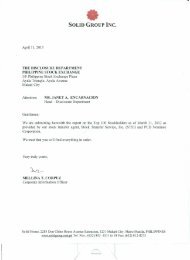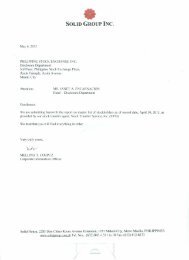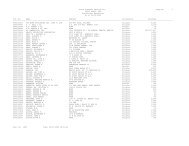2011 Annual Report - the solid group inc website
2011 Annual Report - the solid group inc website
2011 Annual Report - the solid group inc website
Create successful ePaper yourself
Turn your PDF publications into a flip-book with our unique Google optimized e-Paper software.
- 23 -<br />
The translation of <strong>the</strong> financial statements into Philippine peso should not be construed<br />
as a representation that <strong>the</strong> U.S. dollar and Chinese yuan renminbi amounts could be<br />
converted into Philippine peso amounts at <strong>the</strong> translation rates or at any o<strong>the</strong>r rates of<br />
exchange.<br />
2.16 Impairment of Non-financial Assets<br />
The Group’s property, plant and equipment, investment property and o<strong>the</strong>r<br />
non-financial assets are subject to impairment testing. All individual assets are tested for<br />
impairment whenever events or changes in circumstances indicate that <strong>the</strong> carrying amount<br />
may not be recoverable.<br />
For purposes of assessing impairment, assets are <strong>group</strong>ed at <strong>the</strong> lowest levels for which <strong>the</strong>re<br />
are separately identifiable cash flows (cash-generating units). As a result, assets are tested for<br />
impairment ei<strong>the</strong>r individually or at <strong>the</strong> cash-generating unit level.<br />
Impairment loss is recognized for <strong>the</strong> amount by which <strong>the</strong> assets’ or cash-generating unit’s<br />
carrying amount exceeds its recoverable amount. The recoverable amount is <strong>the</strong> higher of<br />
fair value, reflecting market conditions less costs to sell, and value in use, based on an internal<br />
evaluation of discounted cash flow. Impairment loss is charged pro-rata to o<strong>the</strong>r assets in <strong>the</strong><br />
cash-generating unit.<br />
All assets are subsequently reassessed for indications that an impairment loss previously<br />
recognized may no longer exist and <strong>the</strong> carrying amount of <strong>the</strong> asset is adjusted to <strong>the</strong><br />
recoverable amount resulting in <strong>the</strong> reversal of <strong>the</strong> impairment loss.<br />
2.17 Employee Benefits<br />
(a)<br />
Post-employment Benefit<br />
Post-employment benefit is provided to employees through a defined benefit plan. The<br />
Group’s post-employment defined benefit pension plan covers all regular<br />
full-time employees. The pension plan is tax-qualified, noncontributory and<br />
administered by a trustee.<br />
A defined benefit plan is a post-employment plan that defines an amount of<br />
post-employment benefit that an employee will receive on retirement, usually<br />
dependent on one or more factors such as age, years of service and salary. The legal<br />
obligation for any benefits from this kind of post-employment plan remains with <strong>the</strong><br />
Group, even if plan assets for funding <strong>the</strong> defined benefit plan have been acquired.<br />
Plan assets may <strong>inc</strong>lude assets specifically designated to a long-term benefit fund, as well<br />
as qualifying insurance policies.<br />
The liability recognized in <strong>the</strong> con<strong>solid</strong>ated statement of financial position for<br />
post-employment defined benefit pension plans is <strong>the</strong> present value of <strong>the</strong> defined<br />
benefit obligation (DBO) at <strong>the</strong> end of <strong>the</strong> reporting period less <strong>the</strong> fair value of plan<br />
assets, toge<strong>the</strong>r with adjustments for unrecognized actuarial gains or losses and past<br />
service costs. The DBO is calculated annually by independent actuaries using <strong>the</strong><br />
projected unit credit method. The present value of <strong>the</strong> DBO is determined by<br />
discounting <strong>the</strong> estimated future cash outflows using interest rates of high quality<br />
corporate bonds that are denominated in <strong>the</strong> currency in which <strong>the</strong> benefits will be paid<br />
and that have terms to maturity approximating to <strong>the</strong> terms of <strong>the</strong> related<br />
post-employment liability.


